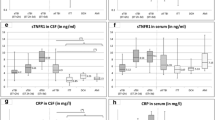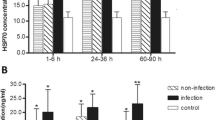Abstract
Background
Gunshot injuries result in serious traumatic tissue damage due to high velocity of the bullet, deep penetration, and ballistic effect. Trauma is known to be related with oxidative stress. Serum thiol levels and disulphide/thiol homeostasis are novel oxidative stress biomarkers. In this study, we aimed to investigate serum thiol levels and disulphide/thiol homeostasis in injury patterns of patients admitted to the emergency department with a gunshot injury.
Method
A total of 128 participants were included in the study. The participants were divided into two groups: the patient group (Group 1; n = 73) and healthy controls (Group 2; n = 55). Native thiol, total thiol, disulphide levels, disulphide/native thiol, disulphide/total thiol, and neutrophil-to-lymphocyte ratio (NLR) were measured. The Revised Trauma Scale (RTS) and Glasgow Coma Scale (GCS) scores were calculated.
Results
Native thiol, total thiol, and disulphide levels were significantly lower in Group 1 (p < 0.001). Disulphide/native thiol ratio, disulphide/total thiol ratio, and NLR were significantly higher in Group 1, compared to Group 2 (p < 0.05). There was a positive correlation between thiol levels and RTS and GCS scores and NLR. Stepwise linear regression analysis showed that native thiol was an independent indicator of RTS and GCS scores. The receiver operating characteristic curve (ROC) analysis revealed that serum native thiol levels of ≤ 342.9 could predict gunshot injury with a sensitivity of 82% and a specificity of 77% (area under the curve = 0.853; 95% confidence interval 0.783–0.924).
Conclusion
Our study results suggest that thiol–disulphide homeostasis is disrupted in patients sustaining gunshot injuries, and thiol levels decrease in correlation with the severity of trauma with a high sensitivity and specificity. As the level of native thiol is an independent predictor of the severity of trauma, reduced thiol levels may be of prognostic value in the early assessment of patients in the emergency room.


Similar content being viewed by others
References
Oymacı E, Kapkaç M, Uçar Y, Ertan H, Özdedeli E, Tokat Y. The effects of gunshot and shotgun wounds to mortality and morbidity. Turkish J Trauma Emerg Surg. 1997;3:132–6.
Hoyt DB, Potenza BM, Cryer HG, et al. Trauma. In: Greenfield LJ, Mullholland MW, Oldham KT, Zelenock GB, Lilimoe KD, editors. Surgery:Scientific Principles and Practise. 2nd ed. Philadelphia: Lippincott-Raven; 1997. pp. 267–421.
Eriş S, Orak M, Al B, Güloğlu C, Aldemir M. factors affecting mortality in patients with gunshot injuries. Marmara Medical Journal. 2009;22(3):181–91.
Papurica M, Rogobete AF, Sandesc D, Dumache R, Nartita R, Sarandan M, Cradigati AC, Luca L, Vernic C, Bedreag OH. Redox changes induced by general anesthesia in critically Ill patients with multiple trauma. Mol Biol Int. 2015;2015:238586. https://doi.org/10.1155/2015/238586. (Review).
Turell L, Radi R, Alvarez B. The thiol pool in human plasma: the central contribution of albumin to redox processes. Free Radic Biol Med. 2013;65:244–53.
Erkus ME, Altiparmak IH, Akyuz AR, Demirbag R, Sezen Y, Gunebakmaz O, Neselioglu S, Erel O. The association between plasma thiol levels and left ventricular diastolic dysfunction in patient with hypertension. Scand J Clin Lab Invest. 2015;75(8):667–73.
Jones DP, Liang Y. Measuring the poise of thiol/disulfide couples in vivo. Free Radic Biol Med. 2009;47(10):1329–38.
Erel O, Neselioglu S. A novel and automated assay for thiol/disulphide homeostasis. Clin Biochem. 2014;47(18):326–32.
Altıparmak IH, Erkuş ME, Sezen H, Demirbag R, Gunebakmaz O, Kaya Z, Sezen Y, Asoglu R, Dedeoglu IH, Neselioglu S, Erel O. The relation of serum thiol levels and thiol/disulphide homeostasis with the severity of coronary artery disease. Kardiol Pol. 2016;74(11):1346–53.
Gokdemir MT, Sogut O, Kaya H, Sayhan MB, Cevik M, Dokuzoglu MA, Boleken ME. Role of oxidative stress in the clinical outcome of patients with multiple blunt trauma. J Int Med Res. 2012;40(1):167–73.
Yıldırım A, Aslan Ş, Ocak T, Yıldırım S, Kara F, Şahin YN. Serum paraoxonase/arylesterase activities and malondialdehyde levels in trauma patients. Eurasian J Med. 2007;39(2):85–8.
Velioglu S. Effects of natural antioxidants on human health. Gıda. 2000;25 (3):167–76.
Rael LT, Bar-Or R, Aumann RM, Slone DS, Mains CW, Bar-Or D. Oxidationreduction potential and paraoxonase-arylesterase activity in trauma patients. Biochem Biophys Res Commun. 2007;361(2):561–5.
Rana SV, Kashinath D, Singh G, Pal R, Singh R. Study on oxidative stress in patients with abdominal trauma. Mol Cell Biochem. 2006;291(1–2):161–6.
Oldham KM, Wise SR, Chen L, Stacewicz-Sapuntzakis M, Burns J, Bowen PE. A longitudinal evaluation of oxidative stress in trauma patients. JPEN J Parenter Enteral Nutr. 2002;26(3):189–97.
Tavazzi B, Signoretti S, Lazzarino G, Amorini AM, Delfini R, Cimatti M, Marmarou A, Vagnozzi R. Cerebral oxidative stress and depression of energy metabolism correlate with severity of diffuse brain injury in rats. Neurosurgery. 2005;56(3):582–9.
Lilios G, Pasare R, Malcea L, Radulescu N. The evaluatıon of oxidative stress in traumatic shock. Cercet Exp Med Chir. 2006;2(1):127–30.
Erel O. A novel automated direct measurement method for total antioxidant capacity using a new generation, more stable ABTS radical cation. Clin Biochem. 2004;37(4):277–85.
Dogru A, Balkarli A, Cetin GY, Neselioglu S, Erel O, Tunc SE, Sahin M. Thiol/disulfide homeostasis in patients with ankylosing spondylitis. Bosn J Basic Med Sci. 2016;16(3):187–92.
Kundi H, Ates I, Kiziltunc E, Cetin M, Cicekcioglu H, Neselioglu S, Erel O, Ornek E. A novel oxidative stress marker in acute myocardial infarction; thiol/disulphide homeostasis. Am J Emerg Med. 2015;33(11):1567–71.
Mellor AJ, Woods D. Serum neutrophil gelatinase-associated lipocalin in ballistic injuries: a comparison between blast injuries and gunshot wounds. J Crit Care. 2012 Aug;27(4):419.e1–5.
Altiparmak IH, Erkus ME, Sezen H, Demirbag R, Kaya Z, Sezen Y, Gunebakmaz O, Asoglu R, Besli F, Neselioglu S, Erel O. Evaluation of thiol levels,thiol/disulfide homeostasis and their relation with inflammation in cardiac syndrome X. Coron Artery Dis. 2016;27(4):295–301.
Kondo Y, Abe T, Kohshi K, Tokuda Y, Cook EF, Kukita I. Revised trauma scoring system to predict in-hospital mortality in the emergency department: Glasgow Coma Scale, Age, and Systolic Blood Pressure score. Crit Care. 2011;15(4):R191.
Köksal O, Ozdemir F, Bulut M, Aydin S, Almacioğlu ML, Ozgüç H. Comparison of trauma scoring systems for predicting mortality in firearm injuries. Ulus Travma Acil Cerrahi Derg. 2009;15(6):559 – 64.
Sheffy N, Mintz Y, Rivkind AI, Shapira SC. Terror-related injuries: a comparison of gunshot wounds versus secondary-fragments-induced injuries from explosives. J Am Coll Surg. 2006;203(3):297–303.
Peleg K, Aharonson-Daniel L, Stein M, Michaelson M, Kluger Y, Simon D, Noji EK, Israeli Trauma Group (ITG). Gunshot and explosion injuries: characteristics, outcomes, and implications for care of terror-related injuries in Israel. Ann Surg. 2004;239(3):311–8.
Martins RS, Siqueira MG, Santos MT, Zanon-Collange N, Moraes OJ. Prognostic factors and treatment of penetrating gunshot wounds to the head. Surg Neurol. 2003;60(2):98–104.
Eftekhar B, Zarei MR, Ghodsi M, Moezardalan K, Zargar M, Ketabchi E. Comparing logistic models based on modified GCS motor component with other prognostic tools in prediction of mortality: results of study in 7226 trauma patients. Injury. 2005;36(8):900–4.
Kuhls DA, Malone DL, McCarter RJ, Napolitano LM. Predictors of mortality in adult trauma patients: the physiologic trauma score is equivalent to the Trauma and Injury Severity Score. J Am Coll Surg. 2002;194(6):695–704.
Qian J, Fang J, Zhu Q, Ma S, Wang W, Zheng Y, Hao G, Deng B, Zhao X, Ding F. Serum protein thiol levels in patients with hospital-acquired acute kidney injury. Kidney Blood Press Res. 2015;40(6):623–9.
Tsai K, Hsu T, Kong C, Lin K, Lu F. Is the endogenous peroxyl-radical scavenging capacity of plasma protective in systemic inflammatory disorders in humans? Free Radic Biol Med. 2000;15(6):926–33. 28(.
Bossola M, Tazza L. Wishful thinking: the surprisingly sparse evidence for a relationship between oxidative stress and cardiovascular disease in hemodialysis patients. Semin Dial. 2015;28(3):224–30.
Erel O. A novel automated method to measure total antioxidant response against potent free radical reactions. Clin Biochem. 2004;37(2):112–9.
Kundi H, Erel Ö, Balun A, Çiçekçioğlu H, Cetin M, Kiziltunç E, Neşelioğlu S, Topçuoğlu C, Örnek E. Association of thiol/disulfide ratio with syntax score in patients with NSTEMI. Scand Cardiovasc J. 2015;49(2):95–100.
Funding
None.
Author information
Authors and Affiliations
Corresponding author
Ethics declarations
Conflict of interest
Buyukaslan Hasan, Gulacti Umut, Gökdemir Mehmet Tahir, Giden Ramazan, Celik Hakim, Erel Özcan, and Dörterler Mustafa Erman declare that they have no conflict of interest.
Informed consent
A written informed consent was obtained from patients or their legal guardians.
Ethical approval
The study protocol was approved by the Ethics Committee of Harran University, Faculty of Medicine. The study was conducted in accordance with the principles of the Declaration of Helsinki.
Rights and permissions
About this article
Cite this article
Buyukaslan, H., Gulacti, U., Gökdemir, M.T. et al. Serum thiol levels and thiol/disulphide homeostasis in gunshot injuries. Eur J Trauma Emerg Surg 45, 167–174 (2019). https://doi.org/10.1007/s00068-017-0900-9
Received:
Accepted:
Published:
Issue Date:
DOI: https://doi.org/10.1007/s00068-017-0900-9




